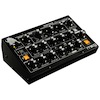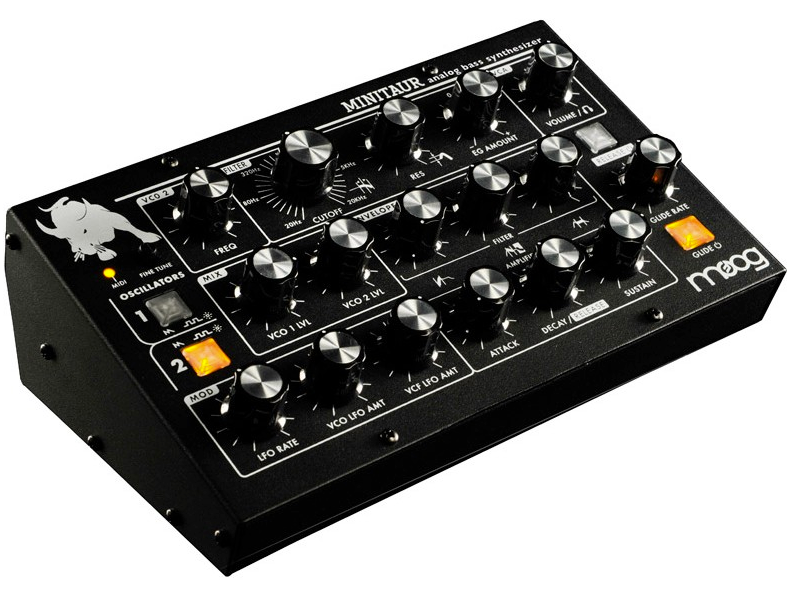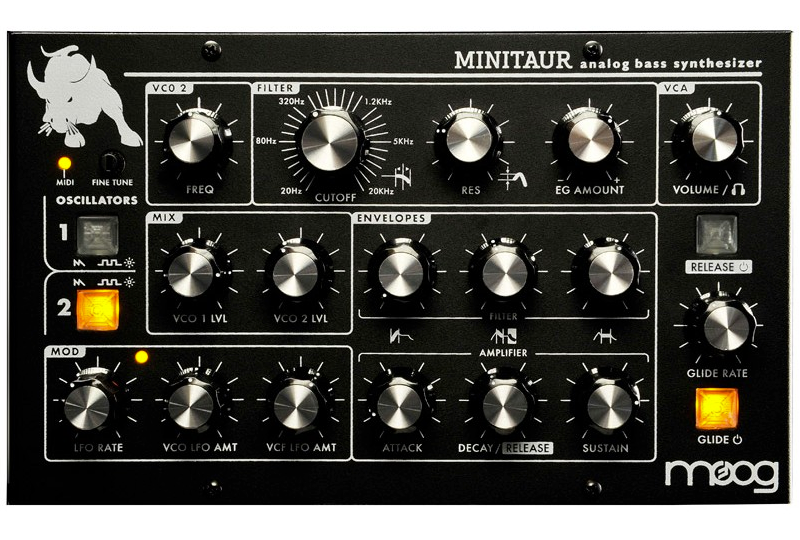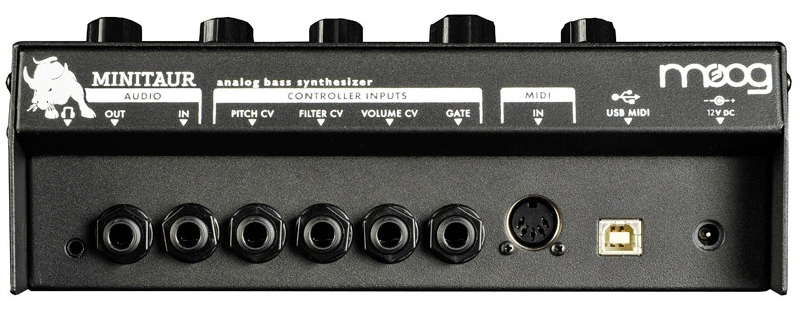MOOG MINITAUR REVIEW
Posted on Tue 13 November 2012 in entries
 You can read more reviews like this, listen to Tony’s productions, purchase synth patches and more at his personal site -> Tony Long Music.
You can read more reviews like this, listen to Tony’s productions, purchase synth patches and more at his personal site -> Tony Long Music.
MOOG MINITAUR - INTRODUCTION
Here is another new Moog product that I am sure will become a classic - the Moog Minitaur Monophonic Analogue Bass Synth. Its engine already has a reputation of being a very powerful analogue synth as it was inspired by the famous Taurus 1 and Taurus 3 pedals. However, it is the first in this family to be designed as a synth module (although you can connect an expression pedal to the CV inputs if you wish to expand it).
The Moog Minitaur has been primarily designed for creating huge monophonic bass sounds, although as I found out, this synth (with its 100% analoge audio path) is capable of so much more.
Anyway, let's turn on the synth and the sub and prepare to create some sounds that will make my walls shake!
MOOG MINITAUR - KNOBS AND BUTTONS
As you open the box there is an interesting Moog leaflet that shows the Moog product range and says 'Devastatingly Heavy Sound'. This leaflet is supplied alongside a packet of ear plugs - very clever! The feeling of excitement is only compounded as you begin to unwrap the synth and are greeted by an angry, snorting bull getting ready to charge towards you! This is all no doubt an indication of the sound you are about to experience!
The Minitaur is very compact, very solid, well built (it has a lovely black metallic housing) and sits on four sturdy rubber feet. It's dimensions are 216 x 76 x 140mm and it weighs just 1.2 kg. The Minitaur's small footprint somehow manages to fit 18 knobs and 4 warm amber buttons on its front panel. However, with 22 controls there is no place for an LCD of any description. Nevertheless, all of the controls are suitably spaced and feel very comfortable for precise editing. As with many modern synths, the Filter Cutoff is the largest knob, tempting you to dive in straight away and start editing your sound! To some extent the knobs and buttons on the Minitaur are arranged in three rows with just the Glide Rate knob between rows 2 and 3 on the right hand side.
At first glance it seems that every function has a dedicated control on the Minitaur - it is not like the Slim Phatty. There are a few exceptions, which you can access via the software editor but we'll have a look at that later on.
On the top left of the Minitaur there is a small MIDI LED and a discreet fine tune knob. This is very sensible and means that you will not accidentally detune everything whilst you are caught up in the excitement of analogue tweaking. The Fine Tune control will adjust the frequency of the Oscillators plus or minus one semitone.
The two buttons labelled '1' and '2' give a solid indication that the Minitaur features 2 oscillators, each of which are switchable between Sawtooth (taken from the original Taurus) and Square wave shapes. Oscillator 2 (VCO 2) is tuneable independently of VCO 1, so you can take it up or down an entire octave. The Mix section allows you to blend the level of VCO 1 and VCO 2 independently. The VCO 2 Frequency dial sets the frequency offset of VCO 2 from VCO 1 from -1 Octave to +1 Octave. If you position it in the centre, you will make it sound in unison with VCO 1.
The Filter section on the Moog Minitaur has a lovely 24 dB/octave resonant Classic Moog Ladder Low Pass filter with full resonance and envelope control. This essentially means that the Minitaur's filter uses a circuit called a 'ladder network', which exhibits a small amount of distortion for a classic Moog sound! Mmmmmm! This is definitely my favourite section as I am sure it is everyone else's!
The Minitaur filter gives a lush, creamy sweep and sounds superb when you add in a touch of resonance. This sadly decreases the bottom end just a little bit but the sound is still great. I think that if I compared the Resonance on the Slim Phatty however, I would say it is better than the one on the Minitaur, but of course you have to take into consideration the price difference and the fact that this is a subjective observation.
The VCF Cutoff control sets the cutoff frequency of the 4-pole Moog Lowpass filter, from 20 Hz to 20 kHz and the VCF Resonance dial sets the gain for the amount of signal from the output of the VCF that is fed back to the input of the VCF. This creates a peak in the frequency response at the cutoff frequency and it can be increased all the way to self-oscillation. Finally in the Filter section is the VCF Envelope Generator, which sets the amount of VCF modulation. The centre position gives you no Envelope Generator modulation, so you do not need to make use of this if you don't want, although for most sound-sculpting purposes, this will be a key area!
Next is the VCA, which controls the overall volume output and there is also a Glide features, which gives you a dialable glide amount that can be switched on or off with the press of one of those amber buttons. You are also able to select via MIDI between 'linear glide' and that of the classic Taurus glide, which rises very quickly.
The Minitaur has an envelope section with twin Minimoog style ADSR Envelope Generators for modulating the Filter (VCF) and Amplifier (VCA). These are great, allowing you to add some lovely detail to your sound - with short attack and decay times you can even produce retro analogue drum sounds!
The Minitaur envelopes feature three knobs each for Attack, Decay and Sustain. If you want to adjust the Release parameter, simply activate the 'Release' button (above the 'Glide Rate' dial) and the Decay knob now controls the sound's Release section. That is a clever idea to save space but I think I would have preferred the unit to be an inch longer and have a separate Release control.
Finally in the modulation section we have got a MIDI-syncable Low Frequency Oscillator (LFO), which has a fixed triangle shape; there are no other waveforms available but the LFO goes reasonably high up into the audio spectrum.
Also in this section is an 'LFO Amount' control for modulating the pitch of the VCOs and a second 'LFO Amount' dial for modulating the VCF. The LFO can be used to create some really cool sound effects - they reminded me of the sort of things you would hear in an old Dr Who episode! If using the Moog Minitaur with a MIDI keyboard, these 'Amount' controls only kick in when you move the Mod Wheel on your controller.
The 'LFO Rate' simply sets the frequency of the LFO with a range is from 0.01Hz right up to 100Hz.
MOOG MINITAUR - SOUND
When you turn the Minitaur on, Moog recommend a warm-up period of about 15 minutes (longer if it has been outside) for it to reach concert pitch. The recommended operating temperature of the Minitaur is between 50 and 100 degrees Fahrenheit (10 to approximately 37 degrees Celcius). It is safe to operate it outside of this range, but its voltage controlled oscillators may not remain in tune.
The Minitaur gets its source signals from the two Voltage-Controlled Oscillators (VCOs). These can then be mixed with any external audio you want to add in. This sound then gets output to the lovely filter, where it gets beautifully sculpted depending on what filter parameters you set and how you have the filter ADSR configured. This signal is then passed to the Amplifier (VCA) stage, where the Volume ADSR envelope shapes it before going to the Output section, where the final earth-shaking sound is set by the 'Volume' control knob.
Ok, so we are warmed up and ready to tweak. When I get a new synth I tend to just dive straight in and start altering parameters fairly randomly to get a feel for what it can do! At first my meddling resulted in Star Wars-like bleeps, but the sounds that I was producing soon began to evolve into powerful snarly squelches with a HUGE low end, which I am sure begins to conjure up some strange images - but I won't go there! If you have ever used a Taurus pedal or have seen bands that do, you will soon realise that the Minitaur is very much part of the Taurus family.
I now have some acid-like sounds which sound very much like more than one Roland TB-303 combined - great stuff! Let's try two Saw waves. Wow - as you bring in the second VCO it really thickens everything up with a fantastic warm buzz. You can obviously tune the oscillators differently to add further thickness or tune them a fifth apart for some 70s retro sounds etc.
Use of the Square waveform adds some extra 'woof', especially when you bring it down an octave, but the fun is when you play with the filter section, which I am sure you know. Don't forget that the Minitaur can also process audio coming in via the audio input. I tried this with a drum machine and made use of the Minitaurís filters etc. to change the sound - loads of fun and it sounded like this might be very useful for genres such as Dubstep.
MOOG MINITAUR - CONNECTIONS
The Minitaur has a mini-jack stereo headphone output, presumably because there was not room inside for a full sized jack. You also have a standard quarter-inch unbalanced Mono Audio Output and an Audio Input that is very useful for processing external audio through the Mixer and Filter section of Minitaur.
Next are the Analogue Control Voltage (CV) and gate inputs, which allow you to control the Minitaur via an external modular kit - great if you have a Moogerfooger! The CV inputs are for Pitch CV, Filter CV, Volume CV and Gate and there's also a MIDI IN (DIN) socket to connect your keyboard or other MIDI gear and a Type B USB input that is solely for MIDI or the Software Editor. Lastly there is the 12V DC Power input.
When you connect the Minitaur to a large keyboard, you will discover that there is only a limited keyboard range assigned - no higher than C72. The manual states that because the Minitaur is a 'bass synthesiser'. it operates exclusively in the lower note range (MIDI notes 0 - 72). This means that it will only respond to your playing from 'C4' (an octave above middle 'C') downward.
MOOG MINITAUR - THE SOFTWARE EDITOR
The Software Editor is available free for you to download when you register your Minitaur at www.moogmusic.com/register.
The Software Editor front end gives you a window that looks identical to the front of the Minitaur but you can't dig down any deeper into the heart of the instrument with the software as editors for some other synths allow you to do.
One of the cool features of the Minitaur Software Editor is a 'Note Sync' button, which allows you to synchronise the waveforms so that they do not go in and out of phase. By activating 'Note Sync' you will ensure that the maximum amount of bass punch is delivered. Also in the editor is a facility for the Glide. With the Glide 'on' you can change whether it plays between key triggers or only if you have another note switched on.
However, the best bit of the Minitaur Software Editor is the 'Patches' section, which allow you to setup and store patches, making it a programmable synth. First of all you have to go to the drop down menu and 'Capture' the sound you have created and then you can simply save and load you sounds at will. There are also now major improvements in version 2 - read on...
MOOG MINITAUR - VERSION 2
The Minitaur can now store 100 presets inside the unit and it doesn't need to be connected to a PC or Mac to play them. There is also an updated Editor V2 to give you complete control over the loading and organising of these presets. To scroll up and down the presets when you are not connected to a computer you just hold down the 'Glide' button and press either the 'Osc 1' or 'Osc 2' button. To revert back to the panel setting you were on before you went into the preset selection, you just hold down the 'Glide' button and press both the 'Osc 1' and 'Osc 2' buttons together.
Another Minitaur V2 addition is that you now get full independent control over the envelope decay and release times. Just press and hold the 'Release' button while turning the 'Decay/Release' knob and that adjusts only the Release Time. If you then just turn the 'Decay/Release' knob you will only adjust the Decay time and leave the Release where you set it.
There are other enhancements in Version 2 and Moog are excited that they have also included something called Control Voltage mapping. This is great if you have other analogue equipment that has CV. Moog say that you can now take the CV inputs on the back of the Minitaur and you can map those to practically any parameter on it.
There is also a new section within the new editor that deals with CV Mapping. This is interesting because this allows for something rather special when it comes to MIDI. Because all of the Minitaur's parameters send out MIDI data over the USB MIDI connection, this means you could take a CV, map it to a Minitaur parameter and then send this out as MIDI data. That is really cool; getting MIDI data from a CV. It's also a very rare thing and opens up possibilities of controlling other MIDI gear you have in your studio.
MOOG MINITAUR - CONCLUSION
If you love analogue sounds I am sure Moog is at the top of your list. Moog products are built extremely well and are made to last. That quality comes at a price but fortunately there is now the Minitaur, which gives you that classic bassy Moog sound at an affordable price.
The Minitaur is a very compact, portable piece of kit that gives you the bottom-end that you simply cannot get anywhere else and plus, its size means you can integrate it easily into any keyboard, DJ or Studio setup. It's also great that the Minitaur is velocity sensitive but I think it's a shame that there is only a limited keyboard range and obviously it would be better with some Pulse Width Modulation, but that would inevitably increase the price.
The release of the free Version 2 update provides you with enhancements to both hardware and software making this purchase exceptional value. I read that Moog is incredibly honoured that the Minitaur is a nominee for the 28th annual TEC awards for Outstanding Technical Achievement - Musical Instrument - Technology/Hardware. There is no doubt in my mind that this synth can move some air and its new ability to act as a CV to MIDI converter opens up a wealth of possibilities. Finally, don't forget to use caution when adjusting initial volume levels, especially if connected to a subwoofer.
For more information on the Moog Minitaur, check out the video below, click the link below or give us a call on 01202 597180.
http://www.youtube.com/watch?v=wdK1zcwuyyU
<span style="font-size: large;">Moog Minitaur - More Info/Buy
******If you're interested in buying and you have seen it cheaper elsewhere, please call us or use our
As well as receiving our first rate customer service you can also claim money off your next purchase with our loyalty points scheme and receive a 3 year warranty if you sign up to our FREE VIP Club (click here for more infomation). Many of our items also come out on a FREE next-day delivery service to mainland UK customers, so you won't be left waiting!
Also, if you want to keep up with all our latest offers, competitions, news and videos, why not follow us on Facebook and Twitter?</span>


